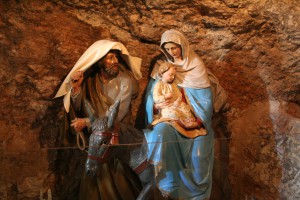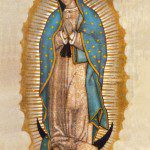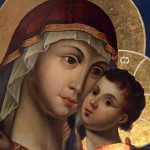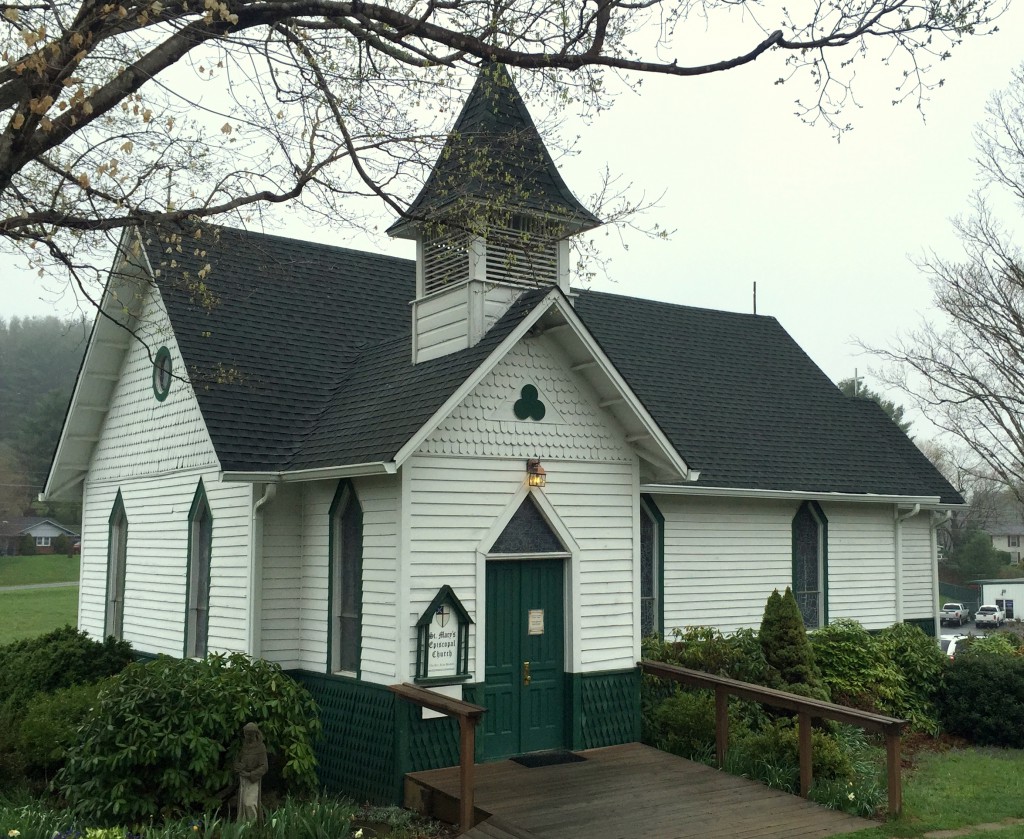Today’s post is the text of a sermon I gave in my home church on one of my favorite topics: the Virgin Mary. The Gospel text for the day is Luke 1:39-55:
In those days Mary set out and went with haste to a Judean town in the hill country, where she entered the house of Zechariah and greeted Elizabeth. When Elizabeth heard Mary’s greeting, the child leaped in her womb. And Elizabeth was filled with the Holy Spirit and exclaimed with a loud cry, “Blessed are you among women, and blessed is the fruit of your womb. And why has this happened to me, that the mother of my Lord comes to me? For as soon as I heard the sound of your greeting, the child in my womb leaped for joy. And blessed is she who believed that there would be a fulfillment of what was spoken to her by the Lord.”
And Mary said,
“My soul magnifies the Lord,
and my spirit rejoices in God my Savior,
for he has looked with favor on the lowliness of his servant.
Surely, from now on all generations will call me blessed;
for the Mighty One has done great things for me,
and holy is his name.
His mercy is for those who fear him
from generation to generation.
He has shown strength with his arm;
he has scattered the proud in the thoughts of their hearts.
He has brought down the powerful from their thrones,
and lifted up the lowly;
he has filled the hungry with good things,
and sent the rich away empty.
He has helped his servant Israel,
in remembrance of his mercy,
according to the promise he made to our ancestors,
to Abraham and to his descendants forever.”
Today’s Gospel reading is among the most beautiful passages in the entire Bible. Mary’s song is known as the Magnificat, a name that comes from the first word of the Latin version of her speech, Magnificat anima mea Dominum: My soul magnifies the Lord. It’s a big speech given by someone whom the world judged as exceedingly small. This young woman of humble birth proclaims that the powerful have been brought down from their thrones and the rich sent away empty. This is not the Mary who stands meekly in a Christmas crèche, her hands folded with downcast eyes. If you listen closely to her song, instead you’ll realize that she is proud, confident—even fierce.
Some of you know that I have a great fondness for Mary (my house contains enough Virgin Mary figurines, candles, and images to stock a good-sized Catholic gift store). I’ve long been fascinated by the lore surrounding her and have visited shrines to her around the world. But until I visited Bethlehem last year, there was a part of her story that I had somehow missed thinking much about. In Bethlehem there’s the grand and imposing Church of the Nativity, an ancient structure that many thousands of people visit each year. But there’s another stop on the pilgrim’s trail that moved even more, a little underground grotto a short walk from the main church. This is the place where tradition says that the Holy Family hid while Herod’s soldiers were searching for the baby Jesus. It’s a much quieter place, this grotto, with low ceilings and a hushed atmosphere.

While the Church of the Nativity is important, that grotto also bears witness to an essential part of Mary’s story. If your image of her is one of quiet passivity, imagine her hiding there, struggling to keep her baby quiet for fear of being discovered, knowing that dangerous men are searching for him. And imagine what she must have felt when she learned that the cost of her family’s escape was the death of all the male children under two in Bethlehem. Surely that experience helped forge in her a fierceness to protect what had been entrusted to her.
This was the world that Jesus was born into, a world of random violence and capricious cruelty. We have ample supporting evidence from other historical sources of the brutality of King Herod, who likely killed the equivalent of one person for every day of his long reign. Mary, Joseph and Jesus spent their lives in a country oppressed both by its own rulers and by its Roman overlords. When Mary sang of the powerful being brought low, she likely could put names to those she had in mind.
Mary is a beloved figure for many reasons, but surely a major one is that she is an icon for mothers. Jesus, for all his wisdom, was never a parent. But Mary knew firsthand what it was like to birth a baby, keep up with a toddler, deal with a teenager, and watch as her adult children struggled.
The author Anne Lamott speculates that Jesus must have been great trial to raise—she says that’s why there’s only one story about his childhood in the Gospels, the one of him being left behind in the Temple. Mary could have told the Gospel writers a lot more hair-raising stories about the young Jesus, but she didn’t want to make her son look bad.
We may smile at that, but there’s probably an element of truth to it as well. Remember that when Simeon sees the baby Jesus being presented at the Temple, he gives a prophecy that this child is appointed for the fall and rising of many in Israel, and then he tells Mary that her heart will be pierced by what is to come.
The heaviest of those sorrows, of course, was watching her son’s death. But there were other sorrows along the way. Jesus would not have been an easy child to parent, even as an adult. We get a hint of the complexities of their relationship in the story of what happened when Jesus was gathered with his followers one day and his family appeared at the door. “Who are my mother and my brothers?” he asks the crowd. “Whoever does God’s will is my brother and sister and mother.” Jesus makes an important point, but if you were his mother, you probably wouldn’t appreciate being made into a rhetorical device. I’m sure she talked to him about that later.
So Mary becomes an icon for the trials of parenthood both large and small. She is a source of comfort for those who have had to bear the tragedy of watching a child suffer and die, but her example is an inspiration for the more ordinary challenges of parenthood as well—of seeing your children ill, of feeling their pain when the world treats them badly or they make mistakes.
In Margaret Atwood’s novel Cat’s Eye, the protagonist is an artist who becomes fascinated by the Virgin Mary. She paints an image of her that is marvelous in its strangeness—a woman with the head of a lioness. The artist says of the picture, “If Christ is a lion, as he is in traditional iconography, why wouldn’t the Virgin Mary be a lioness?… My Virgin Mary is fierce, alert to danger, wild. She stares levelly out at the viewer with her yellow lion’s eyes.”
But there’s another aspect of the painting that is equally strange—this lion-headed Mary is dressed in an overcoat and carries heavy bags of groceries from which several items have fallen. I love that combination of regal fierceness and maternal every-day-ness. The image blends the spirit of the Magnificat with that of the Mary who gave her name to the Catholic church in Garrison Keillor’s Lake Wobegon: Our Lady of Perpetual Responsibility. She’s a woman with a long list of things to do before she sleeps.
I have a friend with a deep devotion to Mary who has taught me a great deal about her symbolic meanings. Her favorite prayer comes from Clarissa Pinkola Estes’ book on Mary called Untie the Strong Woman. It’s a prayer that gives my friend strength to deal with the challenges of a chronic illness and raising her children. It goes like this: “Keep me strong. Keep me fierce. Keep me loving. Keep me able in this world.” Now that’s a prayer worthy of Mary the lioness.
But like any good icon, Mary wears many faces. For all her protectiveness of Jesus, despite the love for him that would take her to Egypt, then back to Nazareth, eventually to Jerusalem, and finally to the foot of the cross, Mary’s deep love is not enough to save her son from suffering and death. The danger that threatened him in Bethlehem would eventually overtake him at Calvary.
Normally in Advent we focus only on the first part of this story, but this year the darker undertones of Lent are also present. Many of us have aching hearts from hearing news of tragedy piled upon tragedy, from the deaths of the two young girls in northern Iowa to the shootings in the Connecticut school last week. In this season, yet another Mary comes to mind: the Pieta, Michelangelo’s sculpture of the grieving mother holding the broken body of her dead son. In this Mary we see a mirror of the grief felt by many today.
I like to think of Mary at the end of her life, sharing her story with Jesus’ disciples. “This is how it all began, many years ago,” she tells them. “I was a young girl who had the most amazing thing happen to me.” And then she tells them of the song she sang, there at the very beginning, and of angels and shepherds and kings showing up unannounced. From the perspective of long years, surely her song about the humble being exalted and the exalted humbled must resonate for her in a way it hadn’t at the time she first sang it. “My soul magnified the Lord,” she tells them. “It still does.”
Let me give you one last image to close these meditations on the meanings of Mary. It’s no accident, I think, that one of the most beloved icons of Mary is of her standing with her hands outstretched. Her stance reminds us that those arms that once held her son so protectively have now released him to us. And in that guise I think she has a special message for us parents. She gently reminds us that no matter how fierce and protective we are, in the end we can’t control the lives of those we love the most. We too must release our children into this often chaotic, dangerous and frightening world—and this release requires as much courage and strength as drawing them close.
This year, more than most, we are reminded that the story of Advent has always been intertwined with longing and loss. Our stories are also intertwined with longing and loss. But Mary knew, and we should always remember, that in the end evil does not win. The light shines in the darkness and the darkness does not overcome it.
So let us pray, with Mary: Keep us strong. Keep us fierce. Keep us loving. Keep us able in this world. Amen.











